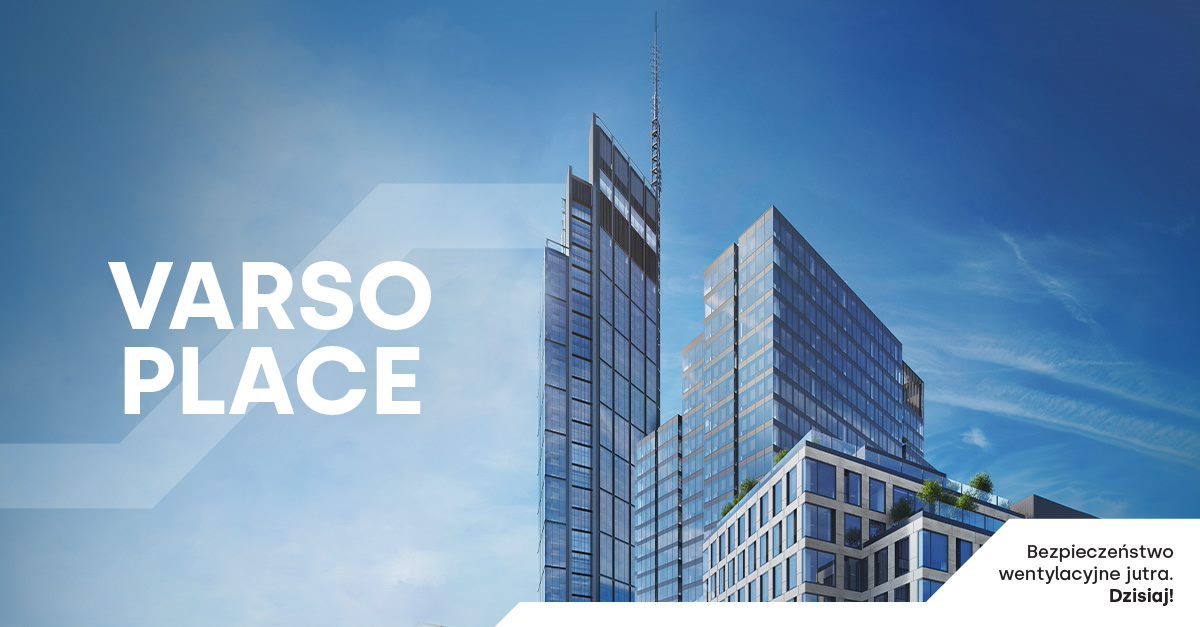Varso Place – the safety aspect of the tallest skyscraper in European Union

Can a breathtaking structure combine exclusiveness, usefulness, quality and safety? Sure! Merging all these components is not only possible, but necessary to create a fully functional building that meets the requirements of both the investor and the end user. You have to combine all these elements to take care of the climate inside and outside of the premises.
It’s time to discover a unique construction project in the very heart of Warsaw: the tallest skyscraper in the European Union and one of the most eco-friendly buildings in the country. Varso Tower is a state-of-the-art high-rise admired by residents of the Polish capital.
Varso Place – a construction project that is changing the Warsaw landscape
Varso Place is a complex of three high-rise buildings located in the centre of Warsaw, next to the Warsaw Central railway station. The tallest of the three, i.e. Varso Tower, has an impressive height of 230 m to the roof and 310 m including a spire surmounting the building. It is this very structure that catches the eye of residents and visitors alike. Varso Tower is not only a prestigious business high-rise, but also a tourist attraction with two observation decks. Very few similar construction projects in Europe offer similar spaces. The first observation deck is located at a height of 205 m, where 16 deciduous trees – single-seeded hawthorns – were planted as they perfectly adapt to unfavourable weather conditions and air pollution.
However, do only observation decks require our attention in such construction projects? Certainly not! The completed buildings of the Varso Place complex have obtained the WELL Health-Safety certification. It is a third-party rating system that takes into account cleaning and disinfection procedures of a workspace, air and water quality management in the office towers (including proper maintenance of air conditioning and ventilation systems), promotion of pro-health behaviours among employees, as well as preparation for crisis situations, e.g. detection of SARS-CoV-2 infections in a building.
One of the factors that contributed to obtaining the certificate was the ventilation system – energy-saving, efficient and limiting the spread of infectious diseases in closed rooms.
Fire protection requirements at the Varso Place
During a typical day, the building users do not pay attention to such important and life-saving factors as the extraction of life-threatening, toxic smoke resulting from a fire. In an emergency, sealed escape routes and their unblocking systems play a vital role. SMAY watches over users by ensuring that the invisible systems are the safest.
The most effective fire protection systems are installed throughout Varso Place – from pressure differentiation systems, developed and patented in Poland, to smoke vents allowing safe emergency evacuation of persons.
The iSWAY-FC product set installed at the Varso Place to ensure differential pressure in smoke and heat control systems, including the Safety Way, is used to generate and maintain positive pressure in protected spaces, which prevents smoke accumulation. The principle of the Safety Way system operation is as follows: within the staircase zones with pressure differential systems a directed air flow of controlled intensity is created. The goal is to obtain a stable static pressure distribution in the whole staircase zone under the stack effect conditions. This can be achieved by means of precise control, in the first place, supply and exhaust air flow, and, secondly, accompanying airflow resistance. It is assumed that in order to obtain a stable static pressure distribution in the entire staircase zone it is necessary to supply a specific volume of air to the negative pressure zone and to channel the right volume of air from the elevated pressure zone.
The solutions installed at the Varso Tower are supported by devices that also facilitate the operation of the Safety Way system. One should note ŻUBR by SMAY – a power supply for ZUP type smoke and heat control systems. This device is supplied by smoke and heat control systems with low and very low voltages. After receiving a signal the relevant constituent module of the power supply switches on/off the power supply to a given consumer unit. If the consumer equipment is used in the non-fire mode, it can be controlled by any control system (it is possible to install its components inside the ZUP housing). In the fire mode (master) for equipment connected to the power supply unit the control signals are sent from the control panels or their modules.
Fire dampers complement efficient fire ventilation systems
SMAY fire dampers are installed in general ventilation systems as barriers or in smoke exhaust systems as elements responsible for controlling the movement of smoke. The main purpose of the dampers is to stop the spread of fire, heat and smoke or to move hot gases.
KTM-E, KWP-LE, KWP-O-E and KWP-P-E fire dampers were installed at the Varso Place. Why these in particular? It was not a random choice. Only matching the right elements can ensure reliable operation of the entire fire ventilation system, as well as passing all acceptance tests and meeting the requirements of even the most sophisticated construction projects. All these dampers are different from each other and, at the same time, complement one another.
The KTM-E dampers with an electric actuator and a return spring consist of a housing of a round cross-section, a moving, single-axis isolating baffle and an actuating mechanism with a release device. The KTM fire dampers are installed in general ventilation systems as isolation baffles separating a fire-engulfed zone from the remaining part of the building (normally open). These dampers stop the spread of fire, heat and smoke.
The KWP fire dampers are used to prevent the expansion of fire, heat and smoke. The KWP-LE and KWP-O-E dampers are designed for installation in ventilation systems as isolating baffles separating fire-engulfed zones from the remaining part of the building. They play a vital role during a fire.
KWP-P are fire dampers that transport air from the pressure differential system and remove hot fire gases from the smoke exhaust system.
Why are dampers so important?
Dampers are mainly responsible for shutting off and regulating the air flow in ventilation ducts. Ventilation dampers are an integral part of a ventilation system that, along with ducts, forms a ventilation pipeline. When selecting dampers for a given system, one should pay attention to many factors: the intended use of a room or premises, velocity and chemical composition of air, control method (manual or automatic), planned operating time, and many others.
The main and, at the same time, basic breakdown of dampers is the distinction between balancing and control dampers. The devices that fulfil the first of those functions limit the amount of air inside a duct. They do not have a gasket on the baffle and therefore do not provide adequate air tightness when fully closed. On the other hand, the control devices, due to the presence of gaskets on flaps, are able to fully block the airflow.
At the Varso Place, the SRC-W-R dampers are installed. Such devices allow controlling or closing the air flow in rectangular ventilation ducts. They can be installed outside buildings, because the actuator and the damper mechanism are protected from direct weather. The design of the damper ensures class 3÷4 integrity rating according to EN 1751. Special sealing inserts at the flap ends ensure high integrity. This guarantees that the device will work even in the most unfavourable conditions.
Air intakes and exhausts – an integral part of a fire ventilation system
Air intakes and exhausts are installed at extremities of ventilation and air conditioning installations. They are used in gravitational, mechanical and fire protection systems. These components are installed at horizontal ventilation duct ends, directly on the outside of wall openings or roof vent plates used to lead ventilation installations through the roof plane.
In construction projects similar to the Varso Place, such elements are necessary for the ventilation systems to work flawlessly. The CDH-B type air intakes are movable louvres controlled by an actuator or set manually. They are used for ensuring air inflow in general ventilation systems. Intakes must be located in a place that provides the cleanest and coolest (in summer) air supply possible. The CDH-B air intakes have movable blades that are set manually or by means of an electric actuator. The blades are made of anodised aluminium profiles and an insert mounted between profiles and secured with a glazing gasket.





